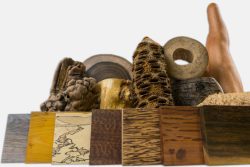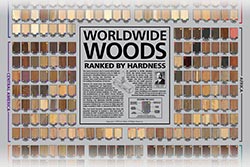> Hardwoods > Sapindaceae > Aesculus
Common Name(s): Buckeye, horse chestnut
Distribution: Temperate regions in the Northern Hemisphere
Genus Size: Approximately 15-20 species, and about 5-10 variants / hybrids
Mechanical Characteristics: Species tend to be rather lightweight, with low to moderate hardness. Strength properties are commensurately low as well.
Visual Characteristics: Buckeye is usually creamy white or light yellow, not clearly demarcated from the white sapwood. Can have grayish streaks. Burls may also contain grayish or red to nearly black coloration.
Identification: Wood is diffuse porous, with small pores and narrow rays that are hard to see even under 10x magnification. Wood can be confused with other soft, diffuse porous hardwoods, especially those in the Populus genus like quaking aspen (Populus tremuloides).
Comments: There are two primary species that woodworkers are likely to encounter, one from Europe (horse chestnut), and the other from the United States (buckeye). Despite two very different sounding common names, the woods are botanically related and are very similar. Of the two, horse chestnut is slightly heavier and stronger (though it is not related to true chestnuts in the Castanea genus).
Related Content:







